20 Different Types Of Conifer Trees: Pictures, Identification Tips, And More!
If you’re fascinated by the diversity of conifer trees, this article is for you! We’ll delve into the world of conifers, exploring their unique characteristics, benefits, and identifying features. From Alaska cedars to White Spruces, we’ll cover over 20 popular types of conifers, including pictures and helpful links to learn more. Whether you’re a homeowner looking for landscaping inspiration or simply curious about these remarkable plants, get ready to discover the world of coniferous trees!
What are coniferous trees?
Coniferous trees, characterized by their cone-bearing nature, are widespread across the globe. A distinctive feature of these trees is their evergreen foliage, which maintains its vibrant green color throughout the year. Additionally, coniferous trees are equipped with thick bark that serves as a natural defense mechanism against fire and pests.
Some of the most prevalent species of coniferous trees include fir, pine, and spruce.
These trees are highly sought after in landscaping due to their aesthetically pleasing appearance and adaptability to various climates. Furthermore, coniferous trees play a crucial role in many ecosystems, providing habitats for an array of animal species.
Coniferous symbolism and meaning.
As a symbol of strength, endurance, and resilience, coniferous trees have captured human imagination for centuries. Their evergreen nature embodies hope and eternal life, making them a powerful representation of the cycles of birth, growth, and renewal. The cones that adorn these majestic trees serve as a reminder of new beginnings and the promise of fresh starts. Meanwhile, the protective needles safeguard against the harsh elements, symbolizing defense and resilience.
It’s little wonder then that coniferous trees have become a beloved choice for Christmas trees, their symbolism resonating deeply with people around the world.
Difference Between Coniferous and Deciduous Trees.
While there’s a wide variety of tree species, they can generally be categorized into two main types: coniferous and deciduous. The key difference between these two categories lies in their leaves’ characteristics and the way they respond to seasonal changes. Coniferous trees are evergreen, meaning they retain their needle-like leaves year-round, whereas deciduous trees shed their broad leaves annually.
Coniferous trees tend to thrive in cold climates and are often referred to as evergreens or Christmas trees. The pine tree is a common example of this type. In contrast, deciduous trees can be found in various climates and are characterized by their broad leaves that change color before falling off the tree. The oak tree is a well-known representative of this category. Several notable differences exist between coniferous and deciduous trees.
Coniferous trees remain green throughout the year, whereas deciduous trees lose their leaves seasonally. Furthermore, coniferous trees primarily inhabit cold climates, whereas deciduous trees can be found in various environments. Additionally, coniferous trees possess needle-like foliage, while deciduous trees boast broad leaves. Despite these differences, both types of trees play crucial roles in the environment.
Coniferous trees provide year-round shelter for wildlife and help prevent soil erosion. Deciduous trees offer shade during the summer and warmth during the winter, while also improving air quality and serving as a food source and habitat for wildlife.
Conifer Identification.
To identify a conifer, start by examining its physical characteristics. Here are some key features to look out for: First, take a closer look at the needles. Typically, conifer needles are long and thin, growing in clusters along the branches. Next, inspect the cones – these seed-bearing structures come in all shapes and sizes, offering valuable clues about the tree’s identity. Additionally, check the bark, which is often thick and scaly on conifers.
Finally, take a glance at the leaves – usually small and scale-like, they can provide further insight into the conifer’s type.
Coniferous Leaves.
While all coniferous leaves share the characteristic of being evergreen, they also exhibit distinct shapes and sizes depending on the tree species. One common trait among these leaves is their needle-like or scale-like structure, which plays a crucial role in water conservation. The varied shapes and sizes of coniferous leaves serve as an adaptation to conserve water.
For instance, long and thin leaves are found on some trees that thrive in cold climates, where the reduced surface area minimizes heat loss to the environment. Conversely, short and wide leaves are typical of trees that inhabit hot, dry regions, where the larger surface area allows for greater heat absorption from the sun. Additionally, needle-like leaves tend to occur more frequently on conifers living in chilly conditions, as their smaller surface area reduces heat loss.
Scale-like leaves, on the other hand, are often associated with conifers dwelling in arid environments, where their larger surface area facilitates greater heat gain.
Conifer cones.
Conifer cones have long been a staple of Christmas decor, evoking warm memories and festive cheer. But beneath their rustic charm lies a fascinating world of biology and diversity. Did you know that there are two primary types of conifer cones: female and male? The female cone is the seed-bearing powerhouse, while the male cone is responsible for producing pollen. Notably, the female cone tends to be larger and more abundant in seeds than its male counterpart.
Beyond this fundamental dichotomy, conifer cones can also be categorized as either deciduous or evergreen. Deciduous cones fall off the tree when ripe, whereas evergreen cones remain attached, often retaining their structural integrity for years to come. Among these categories, pine cones are perhaps the most iconic and ubiquitous variety, hailing from pine trees and typically presenting themselves in shades of brown or tan.
While conifer cones are undoubtedly charming as decorations, they also possess a wealth of practical applications. Crafty enthusiasts can repurpose them into bird feeders, wreaths, and even candles, imbuing these natural wonders with new life and purpose.
Conifer needles.
Conifer needles, those iconic pointy protrusions on evergreen trees, are often misunderstood as being simply part of the tree’s natural architecture. However, they’re actually highly modified leaves designed to persist on the tree for extended periods – sometimes up to several years. This remarkable adaptation enables conifers to thrive in environments where other plants would quickly perish due to cold and arid conditions.
One key feature of conifer needles is their waxy coating, which plays a crucial role in reducing water loss. Additionally, they typically grow in clusters, often consisting of two or more needles. This arrangement not only helps the tree withstand heavy snowfalls but also prevents branches from snapping under the weight. A closer inspection of a conifer needle reveals a small stalk, or petiole, connecting it to the tree.
This stalk enables the needle to pivot and move in response to wind currents. The flattened leaf blade itself is a remarkable example of convergent evolution, where different species develop similar structures to adapt to their environments.
Conifer barks.
Conifer bark is a remarkable feature that comes in various forms, ranging from the robust, scaly exterior of Douglas fir to the delicate, papery layers found on Western hemlock. The unique characteristics of conifer bark often serve as an essential identifier for tree species. Beyond its role in identifying trees, conifer bark plays multiple crucial functions for the tree itself.
It shields the tree from extreme weather conditions, pests, and diseases, while also facilitating water and nutrient storage. Some conifer species even utilize their bark in traditional medicine practices. Conifer bark can be obtained through responsible wild harvesting or cultivated in nurseries. When collecting bark from the wild, it’s essential to avoid harming the tree. Alternatively, fallen trees or branches can provide a reliable source of conifer bark.
Cultivating and harvesting this valuable resource necessitates responsible practices to ensure its long-term sustainability. As a versatile natural material, conifer bark has numerous uses and applications.
Types of conifer trees.
Coniferous trees, encompassing species like pine, fir, and spruce, exhibit distinct characteristics that set them apart from one another. Among these, pine trees reign supreme, reaching majestic heights of up to 100 feet, with their long, slender needles growing in clusters of two to five. The cones themselves are woody, featuring scales that open to release the seeds within.
In contrast, fir trees, though shorter at around 60 feet tall, boast needles that are softer and shorter than those of pines, clustering in pairs. Fir cones, too, are characterized by their overlapping scales, which do not open to disperse seeds. Meanwhile, spruce trees, the smallest of the coniferous bunch, typically reach only about 30 feet tall, with sharp, clustered needles that grow in groups of four to seven. The cones themselves are woody and open to release seeds.
Beyond their unique traits, coniferous trees play a vital role in ecosystems worldwide, providing habitat and sustenance for wildlife, as well as serving as a valuable source of wood for human industries.
Alaska cedar (Cupressus nootkatensis).
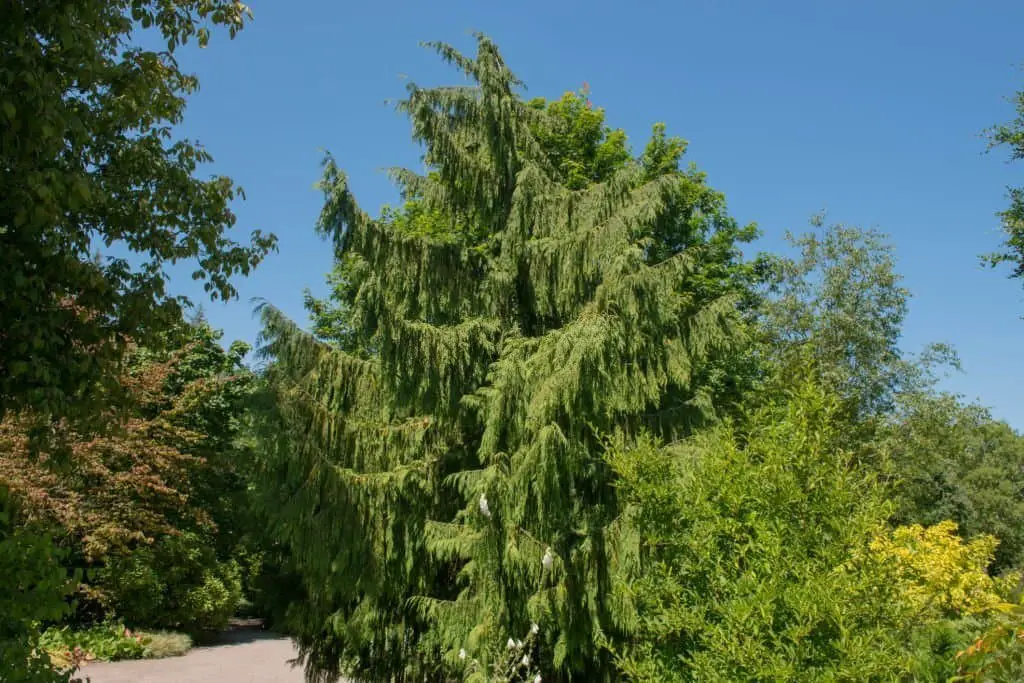
Cupressus nootkatensis, also known as Nootka cypress or yellow cedar, is a species of conifer that thrives in the Pacific Northwest coastal forests ecoregion. Native to British Columbia and southeastern Alaska, this evergreen tree has adapted to its coastal environment over time. Characterized by its large size, Cupressus nootkatensis can reach heights of 250 feet (76 meters) with a trunk diameter of up to 16 feet (490 centimeters).
Its dense foliage forms horizontal to slightly drooping layers, providing a unique canopy. The leaves’ yellowish-brown tips give the species its common name, yellow cedar. The cones of Cupressus nootkatensis are globose and dark blue-black in color, measuring approximately 0.39 inches (0.99 centimeters) in diameter. Each cone contains around 12 seeds.
The wood is notable for its light yellow hue, strength, and durability, making it a prized material for construction projects that require resistance to rot and decay. Yellow cedar has been used in the building of boats, docks, and other marine structures due to its salt-tolerant properties. It also finds applications in furniture, interior paneling, and exterior siding.
Despite its valuable characteristics, Cupressus nootkatensis is classified as endangered by the IUCN due to logging and habitat loss. The species’ range has been significantly reduced, with only a few scattered locations remaining, totaling less than 500 hectares of old growth forest. As such, it is listed as endangered in Canada and threatened in the United States.
Atlantic White Cedar (Chamaecyparis thyoides).
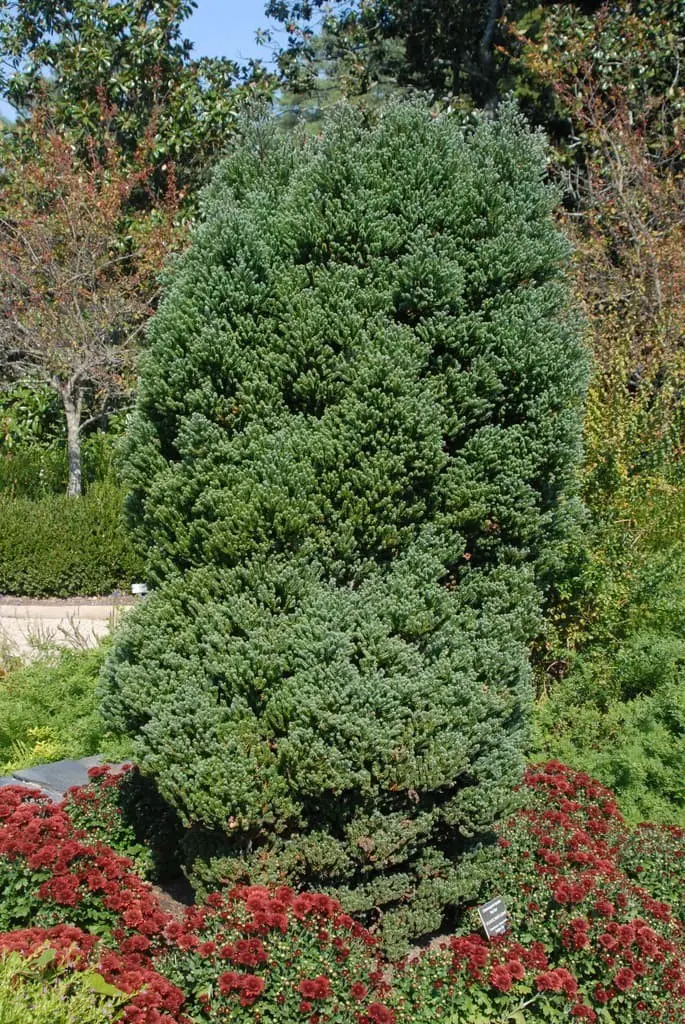
Atlantic White Cedar, a native evergreen tree to North America, thrives in the wild from Maine to Virginia, flourishing in wetland habitats. Its soft, fluffy needles are arranged in flattened sprays, imparting a delicate appearance. The bluish-white tips of the needles add a touch of elegance, while the aromatic scent released when crushed lends an air of sophistication.
The tree’s cones, measuring less than an inch in diameter, start as green and mature to brown, each containing two to three seeds. This versatile tree is often used as a specimen plant or in hedges and screens, with its wood also being utilized in the production of cedar shake shingles and other products. It thrives in full sun to partial shade, preferring acidic, wet soils that can withstand salt spray, making it an ideal choice for coastal planting.
While slow-growing, Atlantic White Cedar can live up to 100 years or more, providing a lasting presence. As a vital source of sustenance and shelter, the tree supports a diverse range of animals, including deer, rabbits, squirrels, songbirds, and game birds. The dense evergreen foliage offers excellent protection from harsh winter winds and snow.
In its natural habitat, Atlantic White Cedar can be found in swamps, old-growth forests, and other wetland areas, where it plays a crucial role in the ecosystem. Its wood is harvested for various applications, including construction, furniture making, and cabinetry, highlighting the tree’s value beyond ornamental purposes.
Balsam Fir Tree (Abies balsamea).
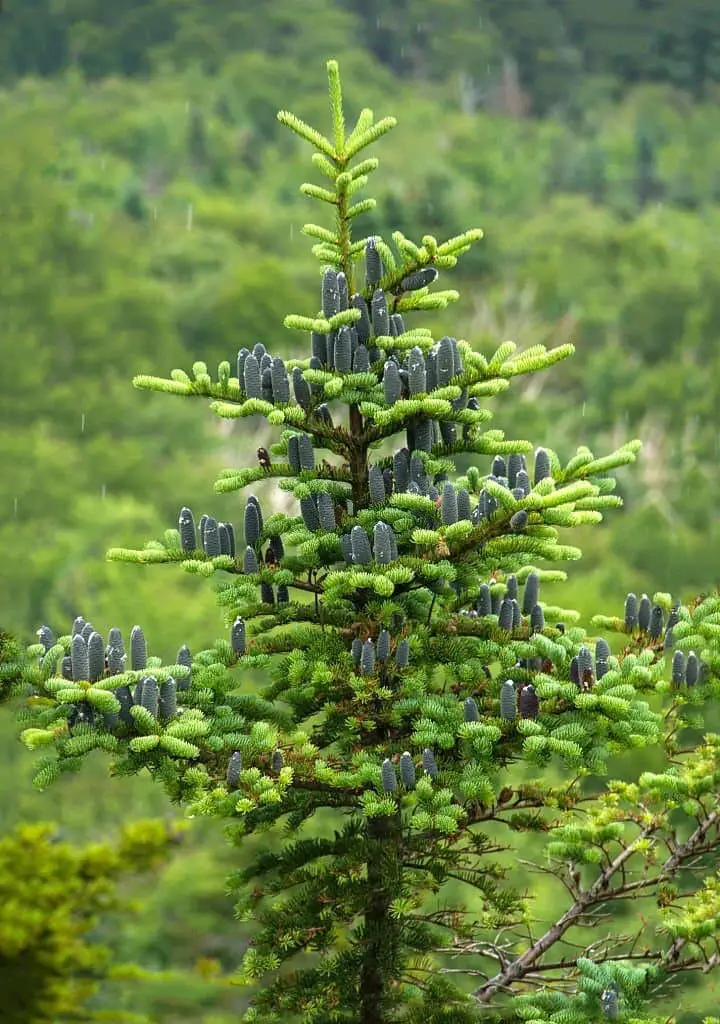
The balsam fir tree, an evergreen conifer, can reach heights of 60-80 feet with a slender, pyramidal shape. Its densely packed needles display a striking contrast in color, transitioning from dark green on top to light green on the underside. Notably, the needles are paired and release a citrusy fragrance when crushed.
As an important source of Christmas trees, the balsam fir tree also finds application in the production of essential oils and balms.
Native to North America, it can be found in eastern United States and Canada, thriving in moist, well-drained soils but tolerating drier conditions as well. This hardy tree is relatively pest- and disease-free, boasting a lifespan exceeding 100 years.
The balsam fir tree plays a significant role in the production of essential oils and balms, with its needles yielding various medicines and treatments.
The extracted oil from the tree is employed in aromatherapy, offering benefits such as stress reduction, pain relief, and immune system boosting.
Black Spruce (Picea mariana).

The black spruce is a remarkable species that can grow up to 30 metres tall, with trunk diameters ranging from 0.5 to 0.7 metres. Its bark is remarkably thin and scaly, with a dark grey-brown hue. The twigs are slender and incredibly flexible, allowing them to bend and flex without breaking. In terms of buds, the black spruce produces conical, brown structures that give way to evergreen leaves that are needle-like in shape.
These leaves are arranged spirally on the shoots, featuring a striking contrast between their dark green topside and the two white stomatal bands below. The cones themselves are small and cylindrical, with a beautiful purple-brown colouration.
This majestic tree is found thriving in cool, wet woods across northern North America, often taking centre stage as the dominant species in the boreal forest.
Its wood, while not particularly strong or durable, is incredibly light and soft, making it an excellent choice for various applications such as pulp and paper production, construction lumber, plywood, and sheathing.
Colorado Blue Spruce (Picea pungens).
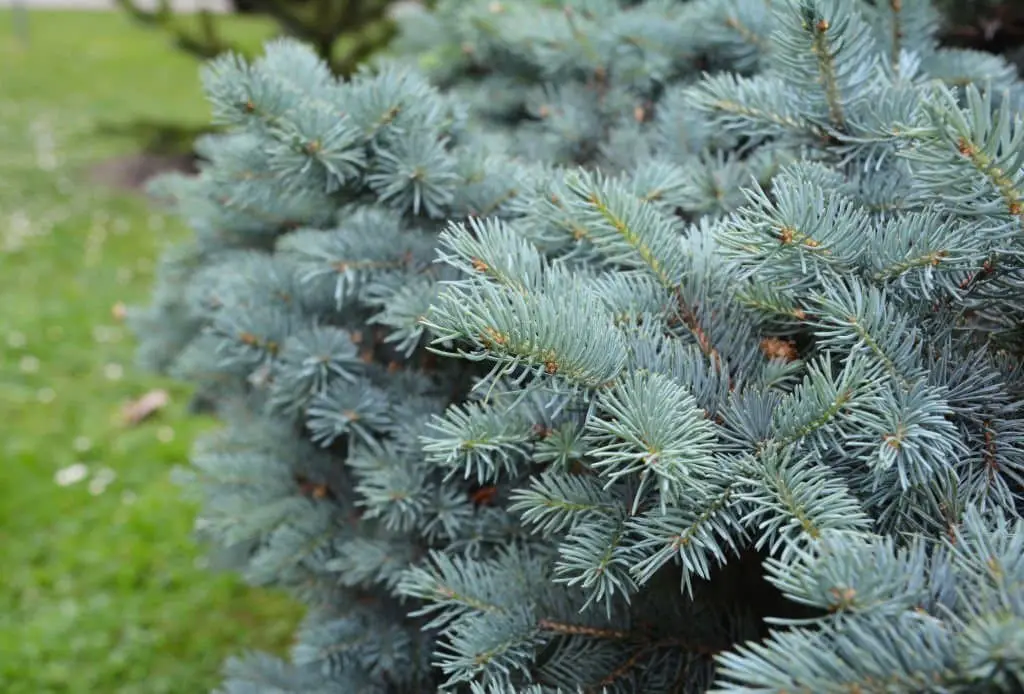
Nestled in the majestic Rocky Mountains, the Colorado Blue Spruce is a stalwart native species thriving at elevations of 6,000 to 10,000 feet. Its unique characteristic lies in its blue-green needles and earthy brown cones, which provide a striking contrast against the rugged mountain backdrop. This tree can grow up to an impressive 100 feet tall and 30 feet wide, making it a commanding presence in any landscape.
Beyond its aesthetic appeal, the Colorado Blue Spruce plays a vital role in the ecosystem of the Rocky Mountains. Its foliage and cones serve as a vital source of sustenance for local wildlife, while also offering shelter from harsh weather conditions. Additionally, humans have long valued this tree for its durable wood and festive potential during the holiday season.
For those seeking to add a touch of mountain charm to their property, the Colorado Blue Spruce is an excellent choice.
Its natural resilience and adaptability make it an ideal selection for landscapers and nature enthusiasts alike.
Colorado Pinyon Tree (Pinus edulis).
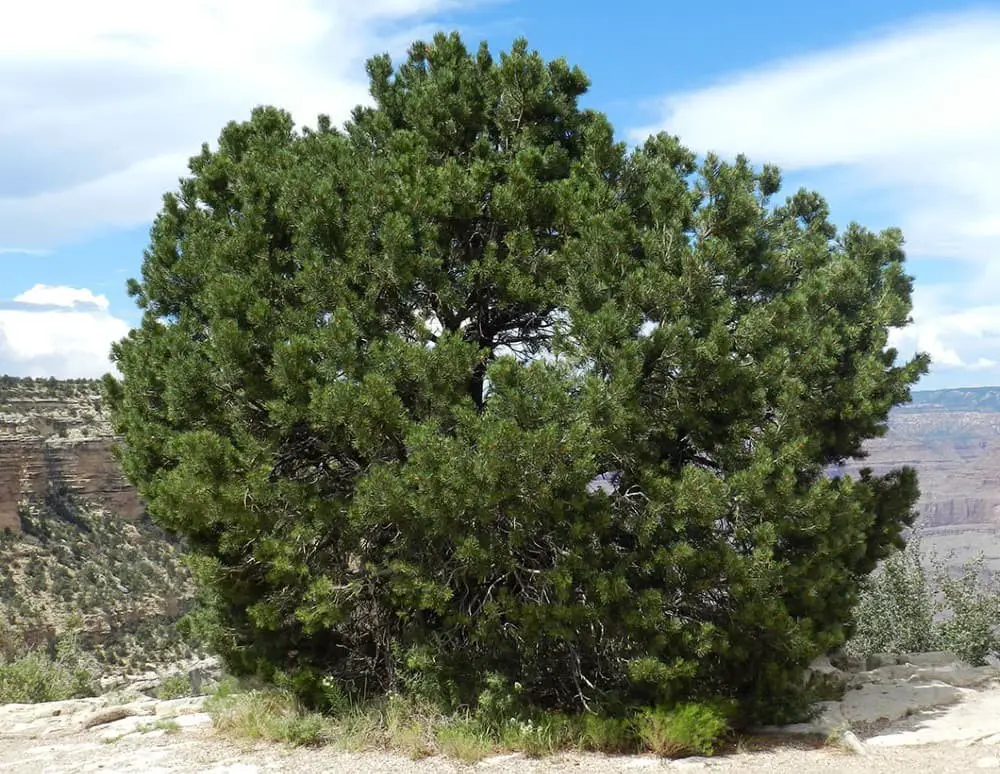
The pinyon tree, a diminutive to medium-sized evergreen coniferous species in the Pinaceae family, has its roots deep in southwestern United States and northern Mexico. The Colorado Pinyon, specifically, thrives in this region, with mature specimens reaching heights of 15-30 feet (0.46-0.91 m) and a trunk diameter of up to 16 inches (41 cm). This slow-growing tree takes its time to reach maturity, requiring approximately 50-60 years.
Characterized by dark green needles and the production of small, edible pine nuts, the Colorado Pinyon plays a vital role as a food source for a variety of animals, including squirrels, chipmunks, mice, birds, and bears.
Douglas Fir (Pseudotsuga menziesii).

The Douglas fir, belonging to the genus Pseudotsuga, is an evergreen conifer that boasts impressive physical characteristics – reaching heights of up to 70 meters (230 feet) and sporting a diameter of up to 15 meters (49 feet). This majestic tree hails from North America, with its native range spanning British Columbia in the north, California in the south, and Montana in the east. Additionally, it can be found in the Rocky Mountains of Colorado and Wyoming.
Interestingly, this species owes its name to David Douglas, a Scottish botanist who first introduced it to European audiences in 1827.
Eastern Larch (Larix laricina).
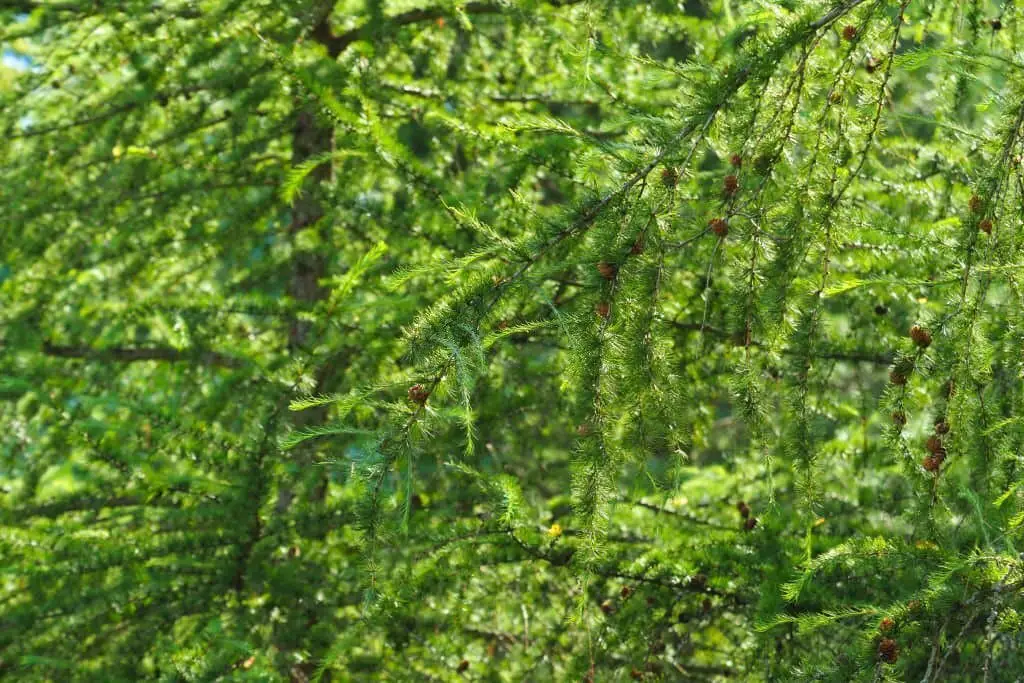
Eastern larch, a deciduous conifer native to North America, holds the distinction of being the northernmost naturally occurring species of its kind globally. As a member of the pine family (Pinaceae), this unique tree boasts characteristics that set it apart from others. Its bark is remarkably thin and scaly, with a reddish-brown to gray-brown hue, while its needle-like leaves, a vibrant yellow-green in color, are arranged in pairs.
The cones themselves are oval-shaped, brown in color, and measure approximately two centimeters in length. Eastern larch can be found thriving in the northeastern United States and southeastern Canada, where it favors full sun and well-drained soils.
Eastern White Pine Tree (Pinus strobus).

The Eastern White Pine holds a special place in the hearts of Mainers and Michiganders, as it’s the official state tree for both states. But its impressive stature isn’t limited to these regions – the tallest recorded white pine stands at 165 feet tall in Washington, a testament to the species’ incredible growth potential.
When it comes to festive traditions, the Eastern White Pine is a popular choice for Christmas trees across North America, with its soft and flexible needles making them a breeze to decorate with lights and ornaments. As for growing conditions, the Eastern White Pine thrives in areas with full sun and moist, well-drained soils.
While it’s surprisingly adaptable and can tolerate a wide range of soil types – including clay – it’s not one for shady spots; this evergreen tree will struggle to grow in areas without sufficient sunlight. And did you know that with proper care, an Eastern White Pine can live up to 200 years or more, making them a long-term investment in any landscape.
Engelmann Spruce (Picea engelmannii).
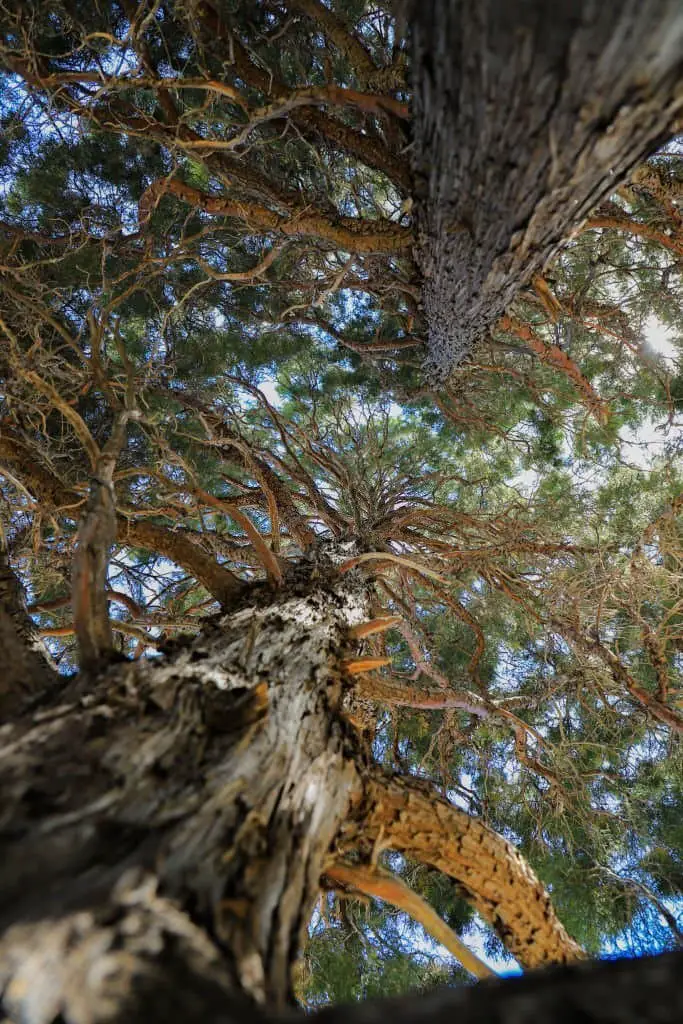
Native to western North America, the Engelmann Spruce is a species that thrives in the Rocky Mountains, spanning from southern British Columbia to Colorado and Utah. This majestic tree can grow up to 50 meters tall, with a trunk diameter of approximately 60 centimeters. Its most distinctive feature, however, lies in its needles – thin and blue-green in hue, they measure between 0.
75 and 15 centimeters in length and are densely clustered on the ends of the branches, giving rise to a unique appearance.
Fraser fir (Abies fraseri).

Native to the Appalachian Mountains in the United States, the Fraser fir is a species of true fir that has garnered recognition due to its distinctive characteristics. Named after botanist John Fraser, who discovered it in 1786, this tree also goes by the monikers balsam fir and Christmas tree. The Fraser fir’s stature reaches an impressive 50-60 feet (15-18 meters) in height, with a diameter of approximately 18 inches (46 centimeters).
Its branching pattern is characterized by horizontal to slightly drooping limbs, while its bark features a smooth, gray-brown texture punctuated by small resin blisters.
Giant Redwood Tree (Sequoiadendron giganteum).

The giant sequoia, Sequoiadendron giganteum, holds the distinction of being the largest living tree on our planet. Reaching incredible heights of over 300 feet tall and boasting diameters of up to 30 feet, these towering trees are an awe-inspiring sight. Native to California’s Sierra Nevada mountains, the giant sequoia has thrived in this environment for millennia.
This remarkable evergreen can live for an astonishing 3,000 years or more!
The tree’s thick, red bark is remarkably fire-resistant, providing it with a natural defense mechanism against blazes. Its small, scale-like leaves are a testament to its adaptability and ability to thrive in diverse conditions.
One of the giant sequoia’s most impressive features is its massive cones, which can reach lengths of up to 12 inches and weigh as much as a pound each! The sheer scale of these cones serves as a reminder of the tree’s incredible size and grandeur.
Grand Fir (Abies grandis).
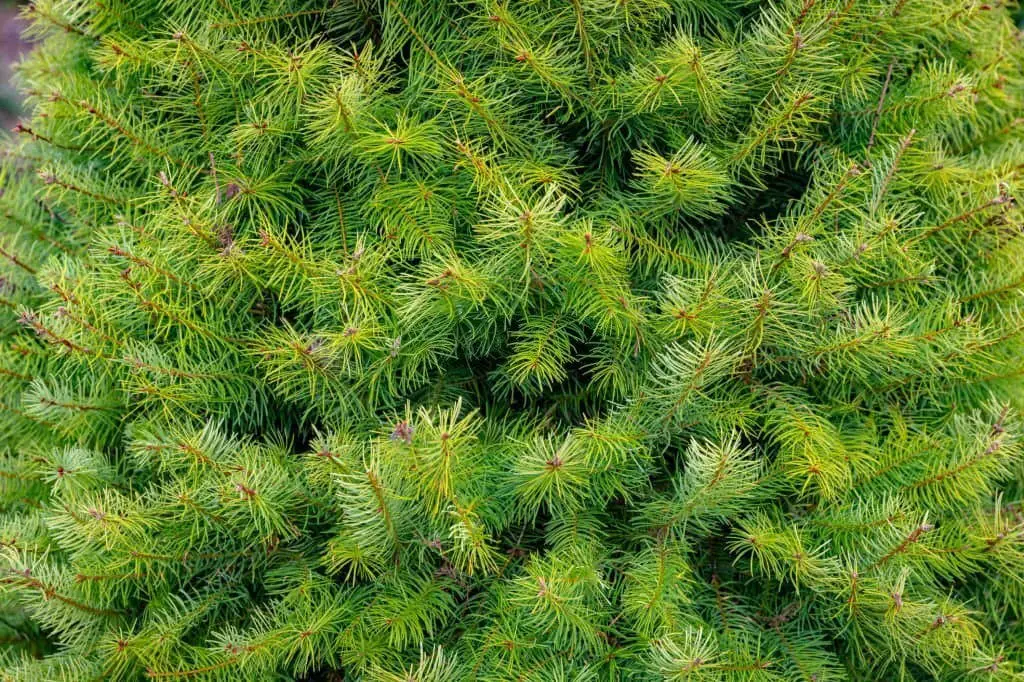
The Grand Fir, a native species of fir, thrives in the Pacific Northwest region of North America, where it can be found growing at elevations ranging from sea level to 1,500 meters. This evergreen coniferous tree reaches heights of 35-60 meters (115-200 feet) and has a trunk diameter of up to 60 centimeters (24 inches). Initially, young trees have smooth, grey bark with white resin blisters, while older trees develop dark brown to black bark that becomes fissured over time.
The needle-like leaves are flat and measure between 15-30 millimeters (0.59-1.2 inches) in length, arranged spirally along the shoots. Notably, each leaf features two distinct whitish bands of stomata on its underside.
Lawson’s Cypress (Chamaecyparis lawsoniana).
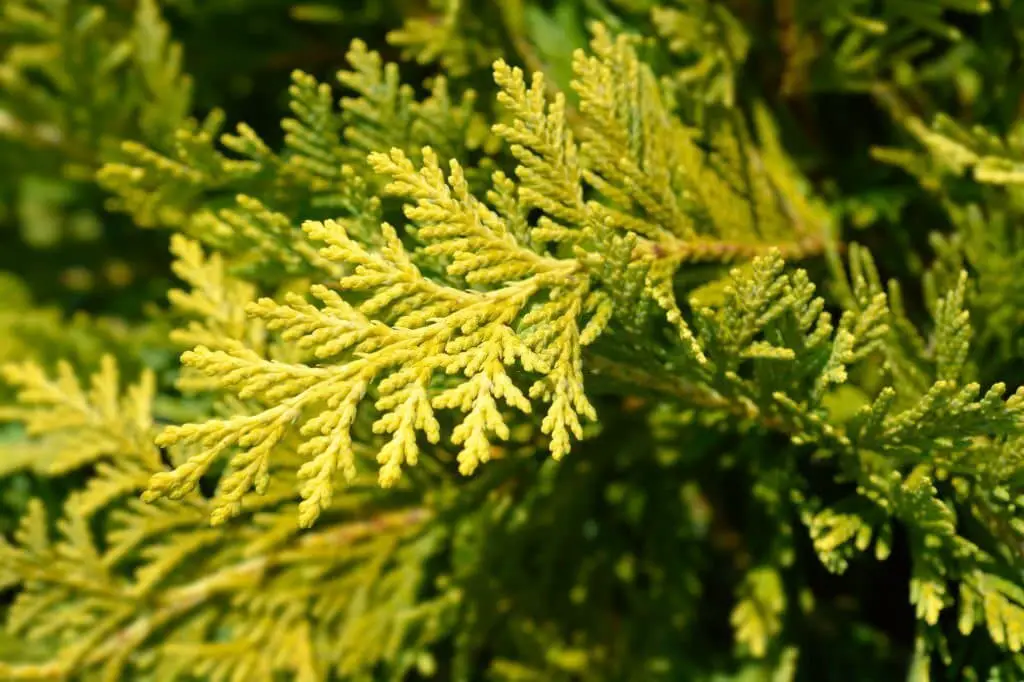
Lawson’s Cypress is a native species to the northwest United States and southwest Canada, characterized by its evergreen coniferous nature. This tree can grow up to 15-25 meters tall, with a trunk diameter reaching up to 60 centimeters. Its leaves are unique in that they resemble scales, arranged in flat sprays with a greenish-blue hue, often featuring a yellow or white central stripe.
The cones of Lawson’s Cypress are rounded and measure around 15-20 millimeters in diameter, comprising 12-16 decussate pairs of scales. Interestingly, these cones take approximately 18-24 months to mature after pollination.
Loblolly Pine Tree (Pinus taeda).
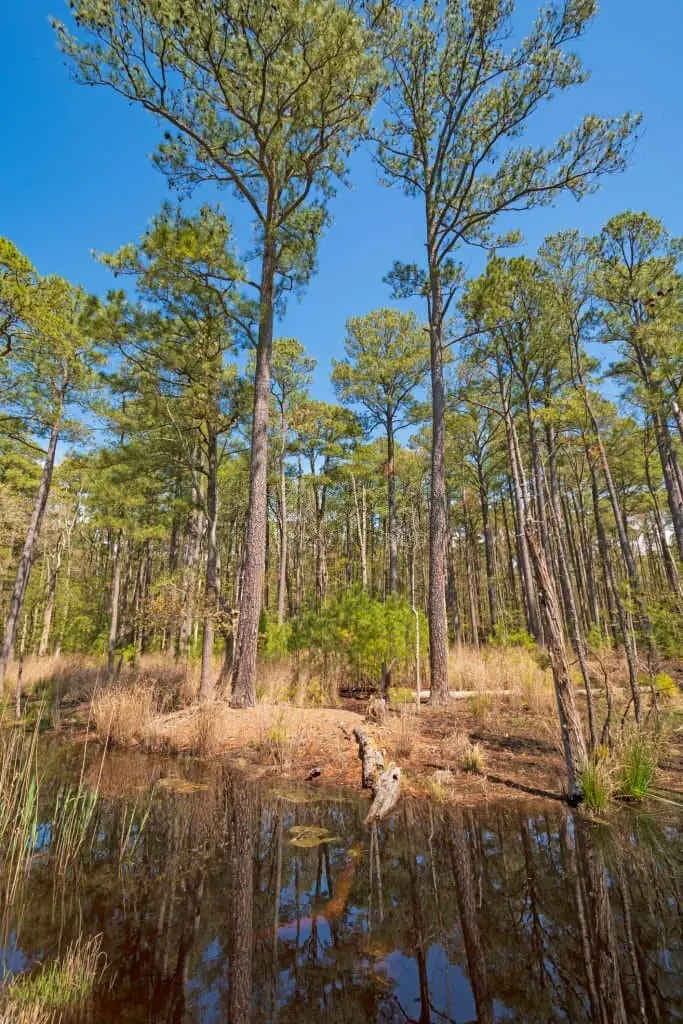
The loblolly pine, scientifically known as Pinus taeda, is a prominent coniferous species that can reach heights of up to 30 meters. The name ‘loblolly’ originates from the tree’s affinity for growing in swampy or muddy environments, while ‘pine’ stems from the Latin term for resin, which can be extracted from its bark. Native to the southeastern United States, loblolly pines are a ubiquitous sight in this region and play a significant role in local ecosystems.
Moreover, their wood is highly valued for industrial applications, including paper production, lumber manufacturing, and other related products.
Longleaf Pine Tree (Pinus palustris).

In the heart of the South, a majestic symbol of resilience and ecosystem importance stands tall – the longleaf pine (Pinus palustris). This iconic tree is renowned for its extraordinary leaves, which can stretch up to an astonishing 18 inches in length. Not only does this remarkable feature earn it its name, but it also testifies to the tree’s remarkable adaptability.
Capable of thriving amidst the harshest conditions – fires, droughts, and hurricanes – the longleaf pine has earned a reputation as a survivor. As a keystone species, it plays a vital role in supporting a diverse array of animal life. Its significance extends far beyond its ecological importance, however. The longleaf pine is an integral part of the cultural heritage of the Southern United States, having once blanketed an impressive 90 million acres of land from Virginia to Texas.
Norway Spruce (Picea babies).

With a majestic presence that can reach heights of up to 100 feet, the Norway spruce is an awe-inspiring tree with a remarkable lifespan of over 500 years. This versatile species plays a crucial role in various industries, including timber and Christmas tree production, as well as providing valuable wood products for furniture, flooring, and paper manufacturing.
Native to Europe’s mountainous regions, spanning from Spain to Russia, the Norway spruce was introduced to North America in the 19th century and has since thrived, becoming naturalized in parts of the northeastern United States.
Pond Cypress (Taxodium ascendens).
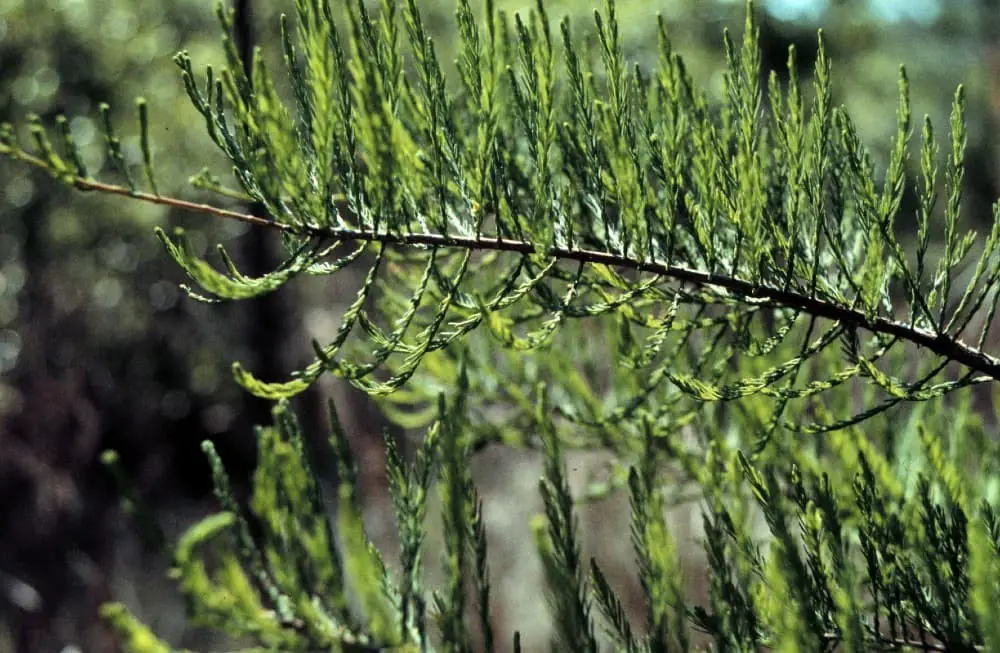
The Pond Cypress boasts distinctive features that set it apart from other trees. Its leaves are simple and deciduous, surrendering to autumn’s arrival as they fall off the tree. The bark is remarkably thin and scaly, displaying a reddish-brown hue that adds character to its profile.
One of the most striking aspects of this tree is its cone production. Small and round in shape, these cones contain approximately 20 seeds each, offering a glimpse into the species’ reproductive cycle.
Native to the southeastern United States, the Pond Cypress thrives in wetlands and swamps, where it can be found in abundance.
As a popular choice for landscaping, the Pond Cypress’s adaptability and ability to flourish in damp conditions make it an attractive option for gardeners seeking low-maintenance beauty.
Tamarack Tree (Larix laricina).
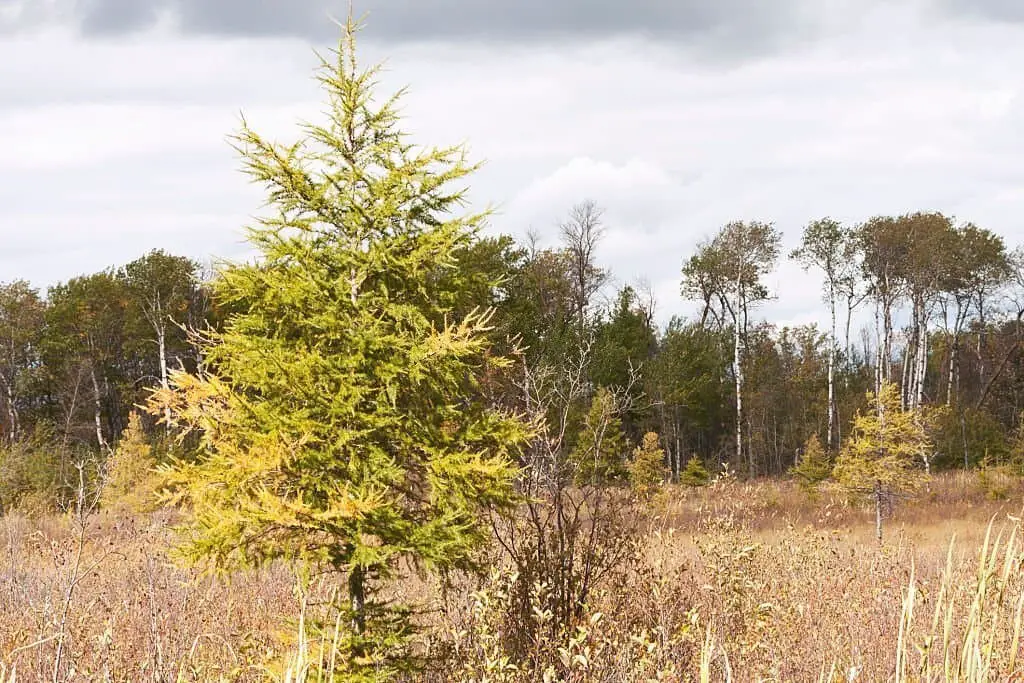
In North America, a unique deciduous conifer stands tall – the Tamarack tree, also known as the American Larch. This adaptable species has earned its name from the Algonquin word ‘tamarak’, meaning ‘wood used for snowshoes’. The Tamarack tree reaches impressive heights of 50-60 feet and boasts a diameter of 18-24 inches, making it a striking feature in the northern parts of North America, stretching from Newfoundland to Alaska.
It thrives in wet, boggy soils and can be found in areas prone to flooding, where its resilience allows it to flourish. As an important tree for wildlife, the Tamarack tree plays a vital role in sustaining ecosystems.
White Spruce (Picea glauca).
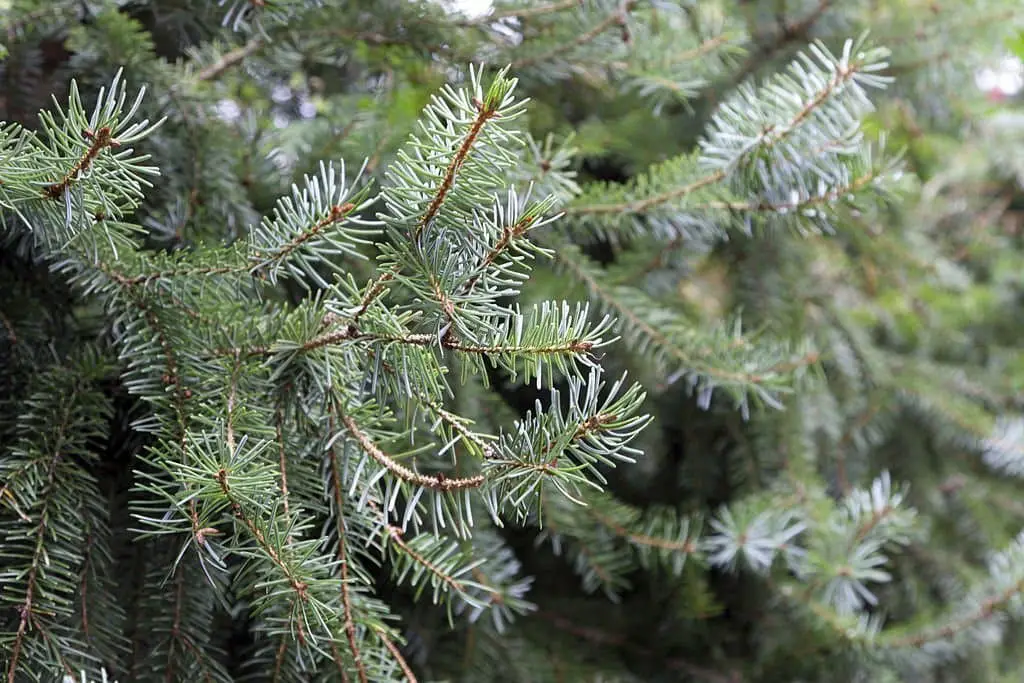
White spruce, also known as black spruce, skunk spruce, and Canada spruce, is a member of the pine family (Pinaceae) that boasts a unique characteristic – its whitish-colored leaf tips. Its scientific name remains unchanged despite the various colloquialisms. The tree’s name has stuck due to its distinctive foliage. This evergreen species thrives in North America, from the frozen tundras of Alaska and Newfoundland to the more temperate climates of Montana, Minnesota, and New Hampshire.
White spruce is a versatile tree that can be found in various habitats, including taiga (boreal forest), subalpine forest, and alpine tundra. It stands tall at 20-40 meters (66-131 feet) with a diameter ranging from 0.6 to 0.85 meters (24-33 inches). Its conical shape features a pointed top, and its leaves are long and needle-like, measuring approximately 0.8-0.95 centimeters (0.31-0.37 inches) in length.
FAQs
Do coniferous trees lose their leaves?
Coniferous trees are a unique group of evergreens that retain their needle-like leaves year-round. While they may experience a change in foliage color during autumn, they do not shed their leaves like deciduous trees do. Instead, they maintain their green hue throughout the winter months. These needle-leaved or scale-leaved trees are often referred to as conifers and include popular species such as pines, firs, and cypresses.
If your coniferous tree does appear to be losing its foliage, it’s likely due to a disease or pest infestation rather than a natural process. In this case, prompt detection and treatment by a certified arborist can help save the tree from potential harm.
What is the most common coniferous tree?
Scots pine, one of the most ubiquitous coniferous trees, can be found in Europe, Asia, and North America. This evergreen tree reaches heights of approximately 30 meters (100 feet), with a robust trunk characterized by thick, scaly bark. The needles, which grow in pairs, are a defining feature of this species. Of note is the distinctive shape and color of the cones, which are oval-shaped and brown.
What is the difference between evergreen and coniferous?
While evergreen trees are characterized by their persistently green leaves, coniferous trees are distinguished by their needle-like foliage and cones. Interestingly, both types of trees have adapted to thrive in different regions around the world. Evergreens tend to dominate warmer climates, where their ability to retain moisture allows them to flourish year-round.
Conversely, coniferous trees are more prevalent in colder climates, where their unique characteristics enable them to survive harsh winters and dry conditions.
Is arbovitae a conifer?
Arbovitae, often misperceived as a standalone entity, actually belongs to the esteemed cypress family. Its scientific name, Thuja occidentalis, reveals its North American origins. This evergreen boasts a unique cone-like shape and scale-like leaves that are meticulously arranged in pairs along its stems. Its distinctive appearance sets it apart from other plants, making arbovitae a fascinating subject for exploration.
Is cedar a coniferous tree?
The cedar, a coniferous tree belonging to the pine family, is native to both North America and Europe. This evergreen species can reach impressive heights of up to 40 meters, boasting needle-like leaves and cones as its defining features. Beyond its striking appearance, the cedar also yields timber, paper, and fuel, making it a valuable resource in various industries.
Conclusion
When considering conifer trees, it’s easy to feel overwhelmed by the numerous options available. But with a little knowledge and understanding of the different varieties, you’ll be well-equipped to make an informed decision about which tree is best suited for your specific needs. By taking the time to learn about the unique characteristics of each type, you’ll be able to find the perfect conifer tree that meets your requirements, ensuring a beautiful and thriving addition to your landscape.
Related Posts
Discovering the vast array of plant varieties available online can be overwhelming. From the classic apple tree to the majestic evergreen, each type has its unique characteristics and benefits. On the other hand, becoming an arborist requires a deep understanding of tree care, including pruning, planting, and maintenance. The impact of trees on a property extends beyond aesthetics, as they also provide shade, improve air quality, and even boost property value.
However, not all trees are created equal – some can actually detract from the appeal of your home. For instance, removing certain species can open up new spaces and enhance overall curb appeal. On the flip side, cultivating a lady palm (Rhapis excelsa) requires specific growing conditions and care. And when it comes to organic blueberry plants in the garden, proper cultivation is key to a bountiful harvest.






